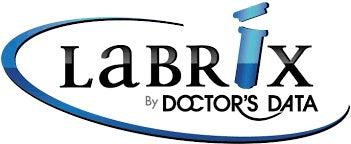Labrix Doctor's Data Neurotransmitter Test, Comprehensive Neurotransmitter Panel
FREE shipping to you and to the lab as well as free email consult to interpret results
Tests 19 parameters
Comprehensive Neurotransmitter Profile includes all of the markers that are part of the NeuroBasic Profile (Serotonin, GABA, Dopamine, Norepinephrine, Epinephrine, Glutamate, Glycine, Histamine, and Phenethylamine), with the addition of the following:
DOPAC: DOPAC is the primary metabolite of dopamine formed via the actions of the MAO enzyme. When DOPAC is elevated and dopamine is low/low range, slowing the activity of the MAO enzyme may help to increase dopamine levels.
3-MT: 3-MT is formed by direct metabolism of dopamine by the COMT enzyme. Very high levels of 3-MT may have stimulant qualities. When 3-MT is elevated and dopamine is low/low range, slowing the activity of the COMT enzyme may help to increase dopamine levels.
Normetanephrine: Normetanephrine is a metabolite of norepinephrine formed via the actions of the COMT enzyme. When normetanephrine is elevated and norepinephrine is low/ low range, slowing the activity of the COMT enzyme may help to increase/maintain norepinephrine levels.
Metanephrine: Metanephrine is a metabolite of epinephrine formed via the actions of the COMT enzyme. When metanephrine is elevated and epinephrine is low/low range, slowing the activity of the COMT enzyme may help to increase/maintain norepinephrine levels.
5-HIAA: Clinically, urinary 5-HIAA is an indicator of serotonin synthesis and metabolism by the MAO enzyme. Some medications as well as dietary consumption of foods rich in serotonin (avocados, eggplant, tomatoes, bananas, melons, pineapple, grapefruit, plums, nuts/nut butters) may elevate 5-HIAA levels. It is recommended to avoid these foods for 3 days prior to sample collection. When 5-HIAA is elevated and serotonin is low/low range, slowing the activity of the MAO enzyme may help to increase serotonin levels.
Tryptamine: Tryptamine is a trace amine derived directly from tryptophan by a vitamin B6-dependent enzyme. Trace amines (tryptamine, tyramine, PEA) may have stimulant effects at high levels. Tryptophan supplementation may increase tryptamine levels. Decreased tryptamine levels may be associated with depression. Tryptamine is normally metabolized by MAO; low enzyme activity may increase tryptamine levels.
Tyrosine: Tyrosine is the amino acid precursor for dopamine, norepinephrine and epinephrine. Low tyrosine levels may increase irritability and lower mood, mental performance, energy levels, body temperature and thyroid function. Tyrosine hydroxylase converts tyrosine into the dopamine precursor L-DOPA.
Tyramine: Tyramine is a trace amine derived directly from tyrosine by a vitamin B6-dependent enzyme. Trace amines (tryptamine, tyramine, PEA) may have stimulant effects at high levels. Foodstuffs such as hard cheeses, chocolates, and red wines contain large amounts of tyramine. Decreased tyramine levels may be associated with depression. Tyramine is normally metabolized by MAO; low enzyme activity may increase tyramine levels.
Taurine: Taurine is an essential amino acid that has an inhibitory effect on neurons; it is important for balancing the action of excitatory neurotransmitters, particularly glutamate. Symptoms of elevated taurine may include apathy, sleep changes, irritability, recklessness, poor concentration, aches and pains, or social withdrawal. Taurine is an ingredient in many “energy drinks.” Decreased CNS taurine synthesis has been reported in individuals with autoimmune and neurodegenerative diseases, including rheumatoid arthritis, Parkinson’s disease, Alzheimer’s disease, and motor neuron diseases such as amyotrophic lateral sclerosis (ALS).





